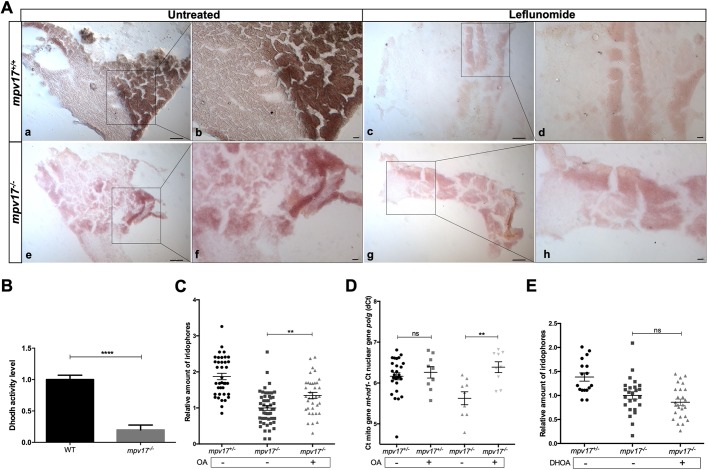Fig. 6.
Analysis of the link between Dhodh functionality and the mpv17 KO phenotype. (A) Histochemical Dhodh assay on cryosections of adult wild-type (a-d) and mpv17 KO (e-h) liver. The activity assay was performed on the same slide and a reaction mix containing 100 μM leflunomide was used as negative control (c,d,g,h). Pictures were taken at lower (a,c,e,g) and higher (b,d,f,h) magnification. Scale bars: 100 µm (n=3). (B) Dhodh biochemical assay in 6 dpf larvae. Dhodh was assessed in zebrafish homogenized through spectrophotometric recordings following the reduction of 2,6-dichlorophenolindophenol (DCPIP). Specific Dhodh activity was obtained by subtracting the leflunomide-independent fraction and measured as nmol/min per mg of protein. Values were then normalized with respect to wild-type controls. Statistical analysis was performed using paired Student's t-test (n=3). (C,D) Relative quantification of iridophore amount in 3 dpf larvae treated with 1 μM orotic acid (OA) (n=36) (C) and mtDNA copy number analysis (n=8) (D). (E) Relative evaluation of iridophore number in 3 dpf larvae treated with 100 μM dihydroorotic acid (DHOA) (n=17). Statistical analyses were performed using two-tailed Student's t-test. Statistical significance was evaluated by setting a confidence interval of 95%; data are mean±s.e.m. ****P<0.0001; **P<0.01; ns, not significant. Experiments were performed in biological replicates.

